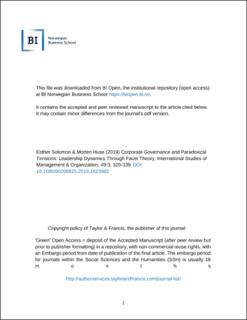Corporate Governance and Paradoxical Tensions: Leadership Dynamics Through Facet Theory
Journal article, Peer reviewed
Accepted version
Permanent lenke
https://hdl.handle.net/11250/2657350Utgivelsesdato
2019Metadata
Vis full innførselSamlinger
- Publikasjoner fra CRIStin - BI [1039]
- Scientific articles [2217]
Originalversjon
International Studies of Management and Organization. 2019, 49 (3), 320-339. 10.1080/00208825.2019.1623982Sammendrag
Relying on a sample of 841 respondents who are board members of Norwegian firms, this study applied Dr. Guttman’s Facet Theory along with nonmetric multidimensional scaling to propose and empirically test structural hypotheses about perceptions of boardroom dynamics. The application of this formal methodology to studying corporate governance processes offers unique insights into leadership dynamics and paradoxical tensions as board members experience them in the boardroom. A facet framework defining the content universe formed the basis for facet profile configurations expressing classes of boardroom dynamics. Results overall confirmed the structural hypotheses and the lawfulness of a radex structure representing boardroom processes. Three facets differentiated among classes of boardroom processes in terms of whether they represent opportunities or threats for cooperation, board asserting or acquiescing roles, and approaching or distancing orientations. These facets represented the qualitative differentiation and jointly played the polarizing role, while a fourth ordered facet on specificity played the modulator role. Director’s perceptions of shared leadership and monitoring comprise enabling orientations and are differentiated from inhibiting orientations that include dominating leadership and biases. The findings have implications for director’s motivation and ability to engage in their monitoring and resource provision roles, or alternatively, contribute to governance inertia.
